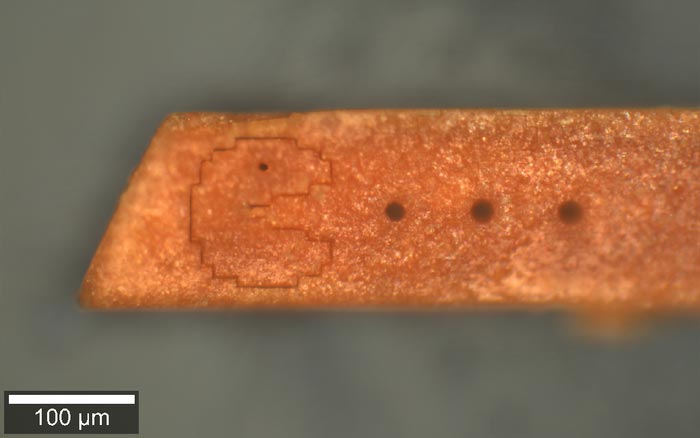A gentler, more precise laser cutting technique

Pac-Man carving by laser cutting
Credit: H. Borchers et al.
Scientists from McGill University have developed a gentler, more precise technique using low-power visible light.
Laser cutting techniques are usually powered by high energy beams, so hot that they melt most materials. Now scientists from McGill University have developed a gentler, more precise technique using low-power visible light.
The new process called ‘cold photo-carving’ uses a fraction of the energy required in traditional laser cutting techniques. “We engineered crystal building blocks that can be cut by low-power light with amazing precision. Unlike traditional heat cutting methods, sculpting down to a resolution of nanometres is possible with our approach because light can be focused more precisely than heat can,” says Professor Tomislav Friščić of the Department of Chemistry.
According to the researchers, the new technique could also be used to engrave complex patterns into surfaces. “Imagine taking the famous geoglyphs in the Nazca Desert in Peru and engraving that pattern at a million-times the reduced size,” say Professor Friščić. The researchers hope that the new approach could one day be developed to create new materials like metals or ceramics that are easily shaped or cut using low-power light and are now looking at potential applications in solar cell materials.
“Cold photo-carving of halogen-bonded co-crystals of a dye and a volatile co-former using visible light” by T. H. Borchers et al. was published in Nature Chemistry.
Media Contact
Shirley Cardenas
McGill University
shirley.cardenas@mcgill.ca
Office: 514-398-6751
All latest news from the category: Life Sciences and Chemistry
Articles and reports from the Life Sciences and chemistry area deal with applied and basic research into modern biology, chemistry and human medicine.
Valuable information can be found on a range of life sciences fields including bacteriology, biochemistry, bionics, bioinformatics, biophysics, biotechnology, genetics, geobotany, human biology, marine biology, microbiology, molecular biology, cellular biology, zoology, bioinorganic chemistry, microchemistry and environmental chemistry.
Newest articles

Sea slugs inspire highly stretchable biomedical sensor
USC Viterbi School of Engineering researcher Hangbo Zhao presents findings on highly stretchable and customizable microneedles for application in fields including neuroscience, tissue engineering, and wearable bioelectronics. The revolution in…

Twisting and binding matter waves with photons in a cavity
Precisely measuring the energy states of individual atoms has been a historical challenge for physicists due to atomic recoil. When an atom interacts with a photon, the atom “recoils” in…

Nanotubes, nanoparticles, and antibodies detect tiny amounts of fentanyl
New sensor is six orders of magnitude more sensitive than the next best thing. A research team at Pitt led by Alexander Star, a chemistry professor in the Kenneth P. Dietrich…





















